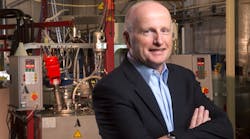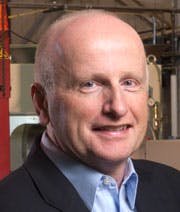"At JM, we believe there's a strong relationship between sustainability and innovation, with one often driving the other," Dr. Tim Swales wrote in Johns Manville's 2012 sustainability report. "Sustainability is becoming increasingly important to our key stakeholders, and companies can either choose to embrace this opportunity or ignore it. We've chosen to embrace it."
See Also: Manufacturing Innovation & Product Development Strategy
Johns Manville, the Denver-based manufacturer of building insulation, roofing and other products with annual sales of $2.5 billion, operates in markets where greater energy efficiency can have huge returns. According to the U.S. Department of Energy, homes and commercial buildings consume more than 70% of all electricity used in the U.S. and about 40% of the total energy. Cutting the energy use of U.S. buildings by 20% could save $80 billion annually.
As an example of how innovation and sustainability are dovetailing, Swales, vice president of research & development and chief sustainability officer, points to JM's introduction of a binder for its HVAC insulation that is made primarily from renewable plant-based materials. The binder acts as a "glue" to hold together the glass fibers and help the product retain its shape. Swales said the binder saves Johns Manville money and provides the customer with an improved product.
Once relegated in many companies to compliance or marketing, sustainability is becoming an increasingly common lever for innovation as companies look at global environmental and demographic trends and seek opportunities to profitably address them.
In its 2012 Sustainability & Innovation Global Executive Study, MIT Sloan Management Review and the Boston Consulting Group (BCG) surveyed 2,600 executives and managers from various industries. Some 48% said they had changed their business model in response to sustainability. Of those, 75% reported their organization either broke even or showed a profit from their sustainability activities and 46% said those activities added to their profits.
Johns Manville takes a broad approach to innovation, categorizing it in four ways that cover not just the development of new products but how the company markets existing products and how it operates its 45 manufacturing facilities:
- Commercial – finding new applications and business models for current offerings
- Operational – step changes to reduce costs and materials usage while delivering better value
- New Products – protect and grow JM's existing businesses while also creating opportunities to enter new markets
- Key Technologies – selectively building leading-edge core technology platforms
Johns Manville's efforts to profit from existing and new sustainable technologies range from the launch last year of a polyiso rigid foam board insulation business called Wall Systems to the introduction of a glass fiber technology that allows a stronger nylon product to be produced to help lower the weight of automobiles and make them more fuel-efficient.
Swales notes that part of his job is to "look into the future" and try to anticipate where the company's markets and customers are headed.
"When we look ahead, we see sustainability becoming more and more important to a lot of our stakeholders," he says.
Eastman Chemical Seeks a Sustainable Advantage
For the past decade, says Eastman Chemical's Anne Kilgore, customers have been routinely coming to the specialty chemicals company and asking for ingredients and additives that offered sustainable solutions for their products. They wanted products that could be produced with less materials and with less energy and other resources.
So when Eastman Chemical established an innovation and sustainability council in 2009 as a vehicle to drive growth through the company, sustainability was already starting to be a factor in product development. Kilgore, Eastman's director of sustainability, noted that the firm's product development cycle can take three to five years. She said it was important to assess what was in the pipeline and then get the research and technical teams thinking about sustainability and how they could start building a portfolio of products that would offer a sustainability advantage.
Eastman set a corporate goal that by 2015, two-thirds of its revenue would come from new products that were "sustainably advantaged," which meant they were at least as green as any alternative available.
One product that marries this combination of innovation and sustainability is Eastman Tritan copolyesters, used in housewares, medical devices and packaging. Kilgore says Eastman wanted to develop a durable plastic that could be used repeatedly, run through dishwashers, put in microwaves and stand up to commercial-grade cleaners. Long life means fewer products ending up in landfills. Moreover, Tritan does not contain bisphenol A (BPA), a chemical linked to possible disruption of the endocrine system and cancer.
Another product with environmental benefits is EnerLogic window film. This product keeps solar heat out in hot weather while trapping heat inside during the winter. Eastman claims EnerLogic adds as much as 92% more insulating power to window glass, providing greater energy efficiency while reducing the need to send existing windows to the landfills.






